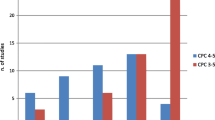Abstract
The prognostic value in 49 children and 56 adults of the following parameters recorded on admission was analyzed: oculocephalic and light reflexes, posturing, Glasgow Coma Scale (GCS), the need for ventilatory support, and the presence of associated injuries. All patients had been in coma for at least 6 h. The presence of intracranial hematoma and the duration of coma were recorded and the relative risk of poor outcome calculated. There was poor outcome in 51% of the children and 61% of the adults. Oculocephalic and light reflexes, posturing, GCS, need for ventilatory support, and duration of coma were significantly related to the outcome in children. Only oculocephalic and light reflexes, and posturing were significantly related to the outcome in adults. Some parameters appeared to have different prognostic value in children and in adults: the simultaneous evaluation of oculocephalic reflex and need for ventilation was the best prognostic guide in children, the light reflex was the best prognostic indicator in adults.
Similar content being viewed by others
References
Armitage P (1982) Statistica medica. Metodi statistici per la ricerca in medicina. Feltrinelli, Milan
Auer LM, Gell G, Richling B, Oberbauer R, Clarici G, Heppner F (1980) Predicting lethal outcome after severe head injury — a computer-assisted analysis of neurological symptoms and laboratory values. Acta Neurochir 52:225–238
Becker DP, Miller JD, Ward JD, Greenberg RP, Young HF, Sakalas R (1977) The outcome from severe head injury with early diagnosis and intensive management. J Neurosurg 47:491–502
Jennett B, Bond M (1975) Assessment of outcome after a severe brain damage. A practical scale. Lancet I:480–484
Jennett B, Teasdale G, Braakman R, Minderhoud J, Knill-Jones R (1976) Predicting outcome in individual patients after severe head injury. Lancet I:1031–1034
Jennett B, Teasdale G, Galbraith S, Braakman R, Avezaat C, Minderhoud J, Heiden J, Kurze T, Murray G, Parker L (1979) Prognosis in patients with severe head injury. Acta Neurochir [Suppl] 28:149–152
Jennett B, Teasdale G, Braakman R, Minderhoud J, Heiden J, Kurze J (1979) Prognosis of patients with severe head injury. Neurosurgery 4:283–289
Jennett B, MacMillan R (1981) Epidemiology of head injury. Br Med J 282:101–104
Kühner A, Roquefeuil B, Viguie E (1973) The influence of high and low dosage of mannitol 25% in the therapy of cerebral edema. In: Schurmann K, Brock M, Reulen HJ, Voth D (eds) Advances in neurosurgery, vol 1: Brain edema. Springer, Berlin Heidelberg New York, pp 81–91
Marshall LF, Smith RW, Raucher LA, Shapiro HM (1978) Mannitol dose requirements in brain-injured patients. J Neurosurg 48:169–172
Marshall LF, Sadler GR, Klauber MR, Bowers SA (1982) Head injuries: how can we compare outcomes? In: Grossman RG, Gildenberg PL (eds) Head injury: basic and clinical aspects. Raven Press, New York, pp 195–201
Moss E, Gibson JS, McDowall DG, Gibson RM (1983) Intensive management of severe head injuries. Anaesthesia 38:214–225
Pazzaglia P, Frank G, Frank F, Gaist G (1975) Clinical course and prognosis of acute post-traumatic coma. J Neurol Neurosurg Psychiatry 38:149–154
Raimondi AJ, Hirschauer J (1984) Head injury in the infant and toddler. Coma scoring and outcome scale. Child's Brain 11:12–35
Stewart WA, Litten SP, Sheehe PR (1979) A prognostic model for head injury. Acta Neurochir 45:199–208
Tofović P, Ugrinovski J, Ruškov P, Zdravkovska S, Simova M, Ancev B (1976) Initial state, outcome, and autopsy findings in a series of 200 consecutive traumatic comas. A computerised analysis. Acta Neurochir 34:99–105
Zuccarello M, Facco E, Zampieri P, Zanardi L, Andrioli GC (1985) Severe head injury in children: early prognosis and outcome. Child's Nerv Syst 1:158–162
Author information
Authors and Affiliations
Rights and permissions
About this article
Cite this article
Facco, E., Zuccarello, M., Pittoni, G. et al. Early outcome prediction in severe head injury: comparison between children and adults. Child's Nerv Syst 2, 67–71 (1986). https://doi.org/10.1007/BF00286223
Issue Date:
DOI: https://doi.org/10.1007/BF00286223




